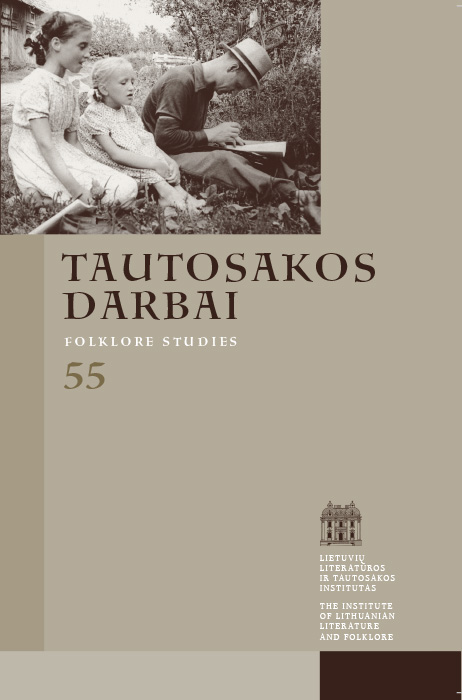Baladės sakytinėje ir rašytinėje tradicijoje: tyrinėjimų retrospektyva
Santrauka
Straipsnio tikslas – apžvelgti užsienio liaudies baladžių tyrinėjimus sakytinės ir rašytinės tradicijų sankirtos aspektu. Retrospektyviai pristatomos kelių užsienio autorių (daugiausia anglų ir amerikiečių, bet taip pat danų, škotų) mintys, po kruopelę įnešančios savo dalį į teorinę baladžių tyrinėjimų bazę, tokią trūkstamą Lietuvoje. Aptariamas Lietuvoje dar menkai žinomas baladžių plitimo per raštą reiškinys (ypač spausdintų lakštų ir brošiūrų pavidalu – broadsides, broadsheets, chapbooks ir pan.), pirmieji baladžių rinkiniai (S. Grundtvigo, F. J. Childo), jų redagavimo nuostatos (teksto kritika), raginimai rinkti balades iš sakytinės tradicijos, bandymai nustatyti sakytinės ir rašytinės tradicijos santykį.
Atsisiuntimai
Nėra atsisiuntimų.
Skaitomiausi šio autoriaus(ų) straipsniai
- Modesta Liugaitė-Černiauskienė, Žvilgsniai į lietuvių folklorinę baladę XX a. antroje pusėje , Tautosakos darbai: T 65 (2023): Tautosakos darbai
- Modesta Liugaitė-Černiauskienė, Jurga Sivickaitė-Sadauskienė, Pratarmė , Tautosakos darbai: T 65 (2023): Tautosakos darbai
- Modesta Liugaitė-Černiauskienė, Folklorinė baladė anapus žanrinio apibrėžtumo , Tautosakos darbai: T 63 (2022)
- Jurga Sadauskienė, Austė Nakienė, Rytis Ambrazevičius, Asta Skujytė-Razmienė, Radvilė Racėnaitė, Gražina Kadžytė, Modesta Liugaitė-Černiauskienė, Vita Džekčioriūtė-Medeišienė, Eligija Garšvienė, Kronika , Tautosakos darbai: T 54 (2017)
- Modesta Liugaitė-Černiauskienė, Jurga Sivickaitė-Sadauskienė, Foreword , Tautosakos darbai: T 65 (2023): Tautosakos darbai
- Modesta Liugaitė-Černiauskienė, Tremtinių, politinių kalinių dainavimas: liminalumo aspektas , Tautosakos darbai: T 61 (2021)
- Modesta Liugaitė-Černiauskienė, Pasaulio baladžių tyrėjų sambūris Vilniuje , Tautosakos darbai: T 57 (2019)
- Modesta Liugaitė-Černiauskienė, Vandens prasmes baladėse apmąstant , Tautosakos darbai: T 50 (2015)
- Modesta Liugaitė-Černiauskienė, Baladė apie baudžiamą dukterį: interpretavimo perspektyva , Tautosakos darbai: T 48 (2014)
- Modesta Liugaitė-Černiauskienė, Jurgita Ūsaitytė, Pratarmė , Tautosakos darbai: T 69 (2025): Tautosakos darbai
